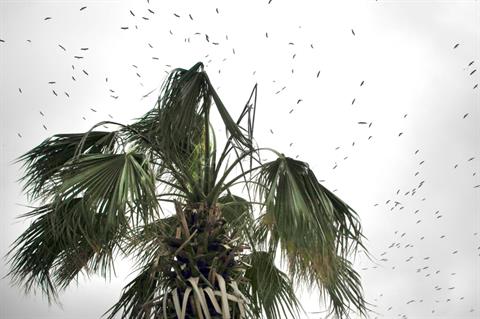
Local stork hunting sparks outrage abroad
Every year, white storks make their spring migration from Africa to Europe, flying hundreds of kilometers across the Lebanese coast, a key migratory corridor for many birds. This year, however, some of them will not make it home, but will instead fall prey to Lebanese hunters who remain oblivious to the poorly implemented hunting ban in the country. The white stork, which has long been depicted in children’s literature and films as the deliverer of babies, is a long-necked wading bird that travels over Lebanese beaches during the months of March and April in order to mate in Europe, where families and farmers eagerly await their arrival. “Everyone loves these birds,” Axel Hirschfeld, press and operations officer at German-based conservation society the Committee Against Bird Slaughter, told The Daily Star. “It is one of the many species that get shot at and are a conservation concern in the European Union.” The issue is taken especially seriously in eastern Germany, he said, and in Poland, which hosts one of the largest white stork populations in Eastern Europe. The bird is seen to represent prosperity, and its presence is considered a blessing. Each year, 35,000 to 50,000 stork couples return to Poland, a board member of Poland’s Grupa EkoLogiczna (Ecological Group), told The Daily Star by email. In Poland, storks are protected by environmental law and also by international agreements, including the European Union Birds Directive, Ireneusz Ka?uga said. “They belong to group of species strictly protected,” he added. “Government and non-governmental organizations alike spend vast amounts of money to protect this species in Poland.” Nests are repaired, injured birds are taken care of and the storks are banded to monitor their migration. The EU and its respective governments have also enacted strict laws whereby shooting birds of prey, such as the stork, can result in a prison sentence and a large fine. But, Hirschfeld said, these efforts have been undermined by Lebanon. “Lebanon is like a black hole,” he said with a sigh. CABS has been in contact with the environmental organization T.E.R.R.E. Liban, as well as the Lebanon Eco Movement, a network of 60 Lebanese nonprofit organizations, to conduct studies and find ways to protect the species. A campaign calling for the safe passage of the stork to parts of Europe, particularly Poland, was launched by T.E.R.R.E. Liban and the Polish Embassy in Beirut a year ago and has been revived this year. Grupa EkoLogiczna has also been in contact with the Polish Embassy to send information leaflets and a short awareness-raising movie. The spark for the various initiatives was the appearance of numerous photos on Facebook showing poachers with dead birds. In some, the animals are laid out in rows or piled on top of one another. The hunters’ faces are often fully visible, a grim reminder of the lack of regard for the country’s poorly implemented hunting restrictions. Hunting any animal at all was banned in Lebanon in 1994. New hunting legislation, Law 580/04, was agreed in 2004, but has not been enforced. “The pictures shocked Europeans,” Paul Abi Rached, founder of T.E.R.R.E. Liban and president of Lebanon Eco Movement, told The Daily Star. “There is a painful cry from the Poles. White storks are not coming home to them.” “In 20 years, is it possible that the government has not been able to control hunting?” Abi Rached asked derisively. Storks are soaring birds, requiring thermal air currents to fly. By late afternoon when temperatures cool down again, they are forced to descend and perch on trees to rest and sleep. That is when they tend to be shot by hunters. Because they fly together in large numbers over Lebanon, many can be shot at one time, Abi Rached said, something evidenced in the photos on Facebook. In a report prepared in June 2013 titled “Report on the Hunting of Migrant Birds in the Lebanon – Affected Species and Their Conservation Status in the EU,” the Lebanon Eco Movement documented 589 pictures posted on Facebook between January 2011 and March 2013 showing at least 13,164 birds killed by hunters, featuring around 143 different species. Instead of hunting storks, Abi Rached said, their migration should be an occasion for “the most beautiful ecotourism in Lebanon.” “Sometimes, almost 500 can be seen at the same time in Lebanon,” he said. “Nobody else can see them like this; it is the miracle of migration. It is a gift from God.”
By Rayane Abou Jaoude – The Daily Star
Source: http://www.dailystar.com.lb